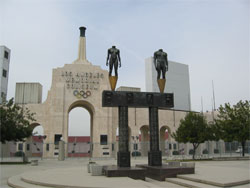Los Angeles 1984 Summer Olympics | |||||
| For the third consecutive time, the olympic summer games in Los Angeles 1984 were struck by a political boycott. This time the boycott was led by the Soviet Union and the rest of the Eastern bloc, with Romania as a notable exception, thereby responding to the Western boycott of the Moscow olympics four years earlier.
The Los Angeles olympics took place from 28th July - 12th August. Around 6.800 athletes from 140 countries participated in Los Angeles 1984, and the boycott was thus considerably less effective compared to four years earlier, when only 80 nations participated. Among others, it was noted that a total of 18 new countries participated for the first time, including several Arab countries and nations from Oceania. The Los Angeles olympics was the beginning of a new era for the olympic games, where commercialization became a key characteristic in the organizational setup. After the terrorist attack in Munich in 1972 and the economic disaster in Montreal in 1976, Los Angeles was the only candidate for the 1984 olympics. At the same time the Los Angeles bid was based on business initiatives instead of government funding and Los Angeles provided a model for many future olympic games. The IOC had selected a new president since the Olympics in Moscow 1980, the Spaniard Juan Antonio Samaranche had replaced the Briton Lord Kilanin. | |||||||
|
Memorial Coliseum Stadium, the Olympic Stadium from 1932 when Los Angeles was also the olympic host city, had been completely renovated and expanded to 93.000 spectators. President Ronald Reagan opened Los Angeles 1984 on 28 July. The opening ceremony was organized by film producer David Volper from Hollywood in party rich style. The Olympic torch was carried into the stadium by Gina Hemphill, granddaughter of the U.S. athletics legend Jesse Owens, and lit by Rafer Johnson, winner of decathlon at the Olympics in Rome 1960. In Los Angeles 1984 athletes competed in the same 23 sports as in the previous olympic summer games in Moscow, but the number of events was substantially increased from 203 to 221. Carl Lewis, USA, was without comparison the dominating athlete at the Los Angeles olympics. With four gold medals at 100 meters, 200 meters, long jump and the short relay he copied Jesse Owens achievement from the olympics in Berlin 1936. Another American, Edwin Moses, was brilliant on the 400 m hurdles by winning gold and backed up by the fact that he had not lost a race since 1977 or what amounted to 105 top level races in a row. In the boxing competitions the coming professional heavyweight champion Evander Holyfield, USA, participated but he was disqualified in the semifinals of the light-heavyweight class for striking after the break. The heavyweight title was claimed by Henry Tillmann, USA. In the Soviet Union and East Germany's absence competitions were clearly dominated by the United States who won a total of 83 gold medals. In second place came the only participating nation from Eastern Europe, Romania, with 20 gold medals. West Germany achieved 17 gold medals and fourth place was taken by a future olympic superpower, China, with 15 gold medals. | |||||||
| Follow this link for a detailed and interactive medal standing for Los Angeles 1984. | |||||
| The story about the Los Angeles Olympics 1984 is based on the official Olympic reports and the Olympian Database. |
 Olympian Database
Olympian Database



